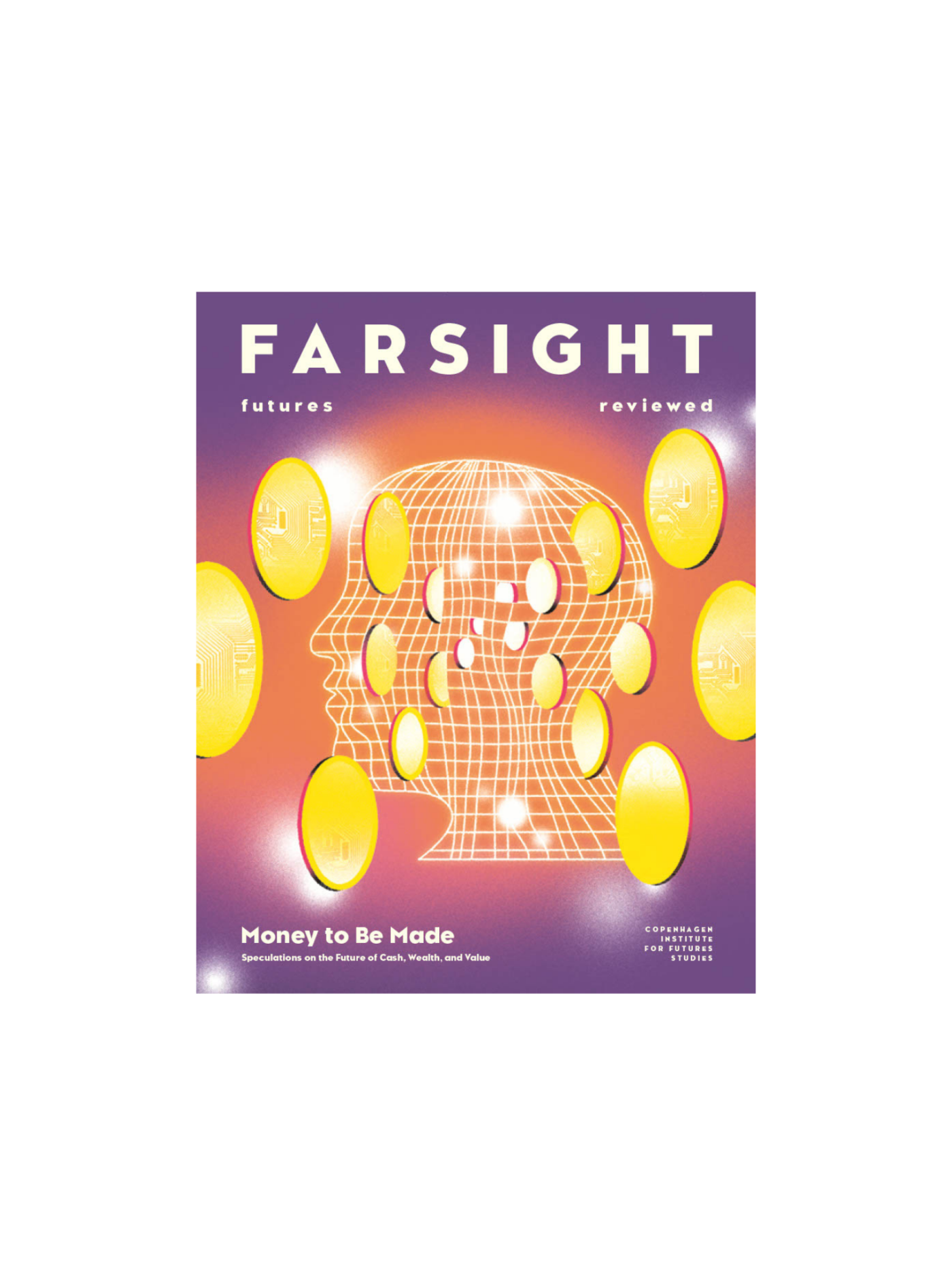
In turn, we use cookies to measure and obtain statistical data about the navigation of the users. You can configure and accept the use of the cookies, and modify your consent options, at any time.

The ‘carbon coin’, first proposed in 2019, then popularised through science fiction, is a proposal for making carbon capture and mitigation profitable – the carrot to carbon taxing’s stick. All it takes is getting the world’s governments and central banks on board. We spoke to Delton Chen, the Australian civil engineer and geo-hydrologist who first thought of the idea.
Photo: Kindel Media
Imagine a future where you’re paid to plant trees, where solar panels and wind turbines don’t just power your home but also earn you money. It’s a world where businesses profit from green-certified buildings, sustainable materials, and farming practices that boost soil health and sequester carbon.
Now, take it further: a financial system that values stability over infinite growth, designed to operate within Earth’s limits. A world where a political consensus to tackle climate change has emerged, and where our resources are funneled into renewable projects instead of fossil fuels. Picture a currency, backed by global banks, that rewards anyone who reduces or captures carbon.

Broaden your horizons with a Futures Membership. Stay updated on key trends and developments through receiving quarterly issues of FARSIGHT, live Futures Seminars with futurists, training, and discounts on our courses.
become a futures memberThese are the kinds of radical concepts envisioned in Kim Stanley Robinson’s 2020 novel The Ministry for the Future, which blends science fiction with urgent climate realities, challenging us to rethink our approach to the planet’s biggest crisis.
After a catastrophic heatwave kills millions and displaces millions more, the world’s governments are finally mobilised into action – even if many do come at it kicking and screaming. Central to the novel is the creation of the titular Ministry for the Future, a governing body designed to advocate for future generations. While the novel explores the many different solutions necessary to tackle a problem as complex as global warming, its message to economists and financial institutions is clear: become part of the solution or perish with the rest of us.
Robinson’s future is one where climate change is finally taken seriously, leading to a realignment of global governance and cooperation between governments and banks (with some goading from eco-terrorists and revolutionaries). This, in turn, shapes the policies and the economy in a way that is not only environmentally sustainable, but also skewed towards financial equality.
His most arresting and complex idea is the notion of a carbon currency. Based on a little-known 2019 paper by Australian civil engineer and geo-hydrologist Delton Chen, the carbon currency idea poses that a new type of currency, backed by the world’s central banks, would be minted for people who remove carbon from the atmosphere and store it over a given period of time (direct air capture), or reduce their carbon emissions over a given period of time (conventional mitigation). It is an audacious idea. But Chen, who I manage to track down, makes it seem simple enough.
“The economy we currently have is unsustainable, because the way it has evolved is for growth and consumption,” Chen says. It’s the kind of opening statement I would expect from an environmental thinker. He also appears to be based in a forest: I can hear birds twittering in the background and glimpse foliage through his study windows.
“If you think about it, one hundred years ago it made perfectly good sense to build an economy poised for growth, because there were only about two billion people on the planet: there was no sense that the world was full or that there were planetary boundaries. What’s changed is that the environment now appears finite, and it’s telling us that if we don’t change, we’re going to collapse our own biosphere,” Chen says.
In this critique, he is not alone: economists across the world are now realising that our current economic system is not equipped to deal with a rapidly changing climate.
“We need to be building an enormous infrastructure of renewable energies as soon as possible – solar, wind. We also need to make sure the consumer goods are in place, so that we can electrify everything,” says Dr Matthew Ryan, an economist with the Climate and Energy Program at the Australia Institute. “We also need to have electric cars, induction cook stoves, heat pumps – all those consumer choices matter. But the current roll-out simply isn’t fast enough; renewables so far are just flattening emissions, not driving them down.”

Explore the world of tomorrow with handpicked articles by signing up to our monthly newsletter.
sign up hereThe problem is that the capital needed to build this infrastructure is enormous. Consultancy firm McKinsey estimates total global spending by governments, businesses, and individuals on energy and land-use systems will need to rise by three and a half trillion USD a year, every year, if we are to have any chance of getting to net-zero by 2050. This is where Chen sees the role of central banks and carbon currency as essential.
“Central banks are in the business of influencing people and markets psychologically. If the carbon currency is backed by central banks so that it will rise in value, it makes the currency a rather predictable and rational investment, and with low sovereign risk. This provides a guarantee that instils confidence in private investors to purchase the currency, making it an attractive investment option.”
This expected rise in value, Chen explains, would result from the carbon coin being directly linked to carbon reduction and sequestration efforts. As the world progresses towards stricter climate targets and demand for decarbonisation grows, the issuance of new coins would represent increasingly scarce climatepositive outcomes. Demand for carbon coins, Chen assesses, would also come from companies needing to demonstrate their sustainability commitments or participate in carbon markets. None of the goals of the carbon coin could be achieved if it isn’t viewed as a compelling asset class.
Chen sees the carbon currency – and more broadly, the Global Carbon Reward theory he conceived a decade ago – as the missing narrative in the decarbonisation debate, and says it integrates economic and political perspectives, aiming to satisfy all stakeholders’ viewpoints, from policymakers to workers and businesses. “Unlike traditional taxes, which use a ‘stick’ approach, the Global Carbon Reward provides a financial ‘carrot’ by utilising profit motives. It aims to be a scalable alternative that complements taxes, reducing resistance for businesses affected by strict regulations,” he says. Chen emphasises that the currency would not be a ‘medium of exchange’ and would not compete with the USD or other national currencies in international trade, although it could be convertible to other currencies.
The carbon coin would also differ from traditional subsidies, which are typically distributed upfront, in that they would only be issued for verified results to avoid inefficiencies or misuse. The project’s success would be intimately tied to the ability to build strong international and institutional cooperation and carefully designed monetary policies with rigorous oversight to avoid the many potential pitfalls.
Since the value of carbon coin would not be pegged to any existing currency, inflation is one of those potential issues. The more emissions are reduced, the more carbon coins would be in circulation. Traditional economics dictates that this increase in supply would lower the value of the currency and make it less attractive.
Chen’s suggested solution is a kind global monetary authority – something akin to the IMF today – which would control supply and coordinate with central banks to manage inflation and other monetary impacts. It’s an ambitious goal, especially considering how elusive a global commitment to the much more mainstream notion of a carbon tax has been.
Ryan, like all good environmental economists, has also read Robinson’s book and reckons the carbon coin has merit. “What’s most exciting about the carbon coin is that it’s different to how we are currently setting up carbon markets,” he says. “It’s the idea of using monetary policy, central banks, or the fiscal powers of states to pay people to do good things when it comes to the environment, such as carbon management, renewable projects, and so on. What we don’t need to do is tie those good things to real carbon emissions by companies, as we do with the carbon credits scheme we now have.”
A carbon credit is a scheme that allows businesses to atone for their carbon emissions by buying credits to fund projects that are supposed to remove emissions from the atmosphere. The idea of carbon credits, or carbon offsetting, is that someone else has reduced or avoided a tonne of CO2 so a business can buy the credit that represents that reduction and use it to ‘offset’ their own emissions. Economists like Ryan liken it to an accounting trick that simply allows profitable – and usually highly polluting – companies to buy their way out of making a tangible environmental difference.
“The problem with carbon credits is that if you want to do a good thing, such as improve soil carbon or forest cover on your land if you’re a farmer, the only way you get paid to do this is if someone else is doing the bad stuff – like emitting carbon through fossil fuels – and buying carbon credits to offset emissions,” says Ryan. “The carbon coin is a great idea in that it encourages people to sequester carbon, which then becomes the thing that global value is tied to. It breaks the link between fossil fuels and carbon sequestration.”
There are mounting examples of failed carbon offset initiatives. One example is an Australian government program which provides carbon credits to companies and farmers who are actively regenerating native forests by stopping routine agricultural clearing or reducing grazing and removing feral animals. When researchers from two Australian universities examined these reforestation projects (the largest nature-based pure carbon removal offset projects in the world) they found “such huge failures that it’s almost beyond belief.” Far from regenerating forests, the researchers found that “most of the selected areas have never had forests, are unsuitable for forest regeneration, and are not producing the increase in tree canopy cover that projects are being credited for.”
In 2023, The Guardian, Die Zeit, and SourceMaterial, a non-profit investigative journalism organisation, conducted a nine-month investigation into Verra, the world’s leading carbon standard for the rapidly growing 2 billion USD voluntary offsets market. They found that more than 90% of their rainforest offset credits are likely to be “phantom credits” and do not represent genuine carbon reductions.
These examples show that the current way of using financial tools to mitigate the climate disaster needs a significant rethink.
Since the success of a carbon coin, like carbon credits, relies on the ability to accurately verify carbon reduction efforts, it could face similar challenges in that the coins themselves risk being backed by phantom reductions. The same trust issues that plague current carbon markets is a challenge that would need to be solved.
While Chen acknowledges these critical issues, he believes the reward-structure of the carbon coin, as a contrast to the punitive approach of carbon taxes, makes it a superior alternative to carbon offsetting as a source of mitigation finance.
“Earning the carbon currency for emissions reductions is a much better option to carbon offsetting,” he says, adding that carbon offsetting is essentially a “zero sum game” for the climate – and it creates new risks for corporations in relation to their carbon accounting, business practices, and marketability. “The Global Carbon Reward can resolve these problems,” Chen believes.
Ryan, while supportive of the scheme, is nonetheless sceptical of Chen’s assertion that nobody needs to lose out. “We can think of a carbon currency as a financial technology, like a car or table are physical ones, and I don’t think a technology will get us around a political conflict,” Ryan says. “There are people who have enormous investments in fossil fuel infrastructure now, and we need them to lose,” he says. “Because if they realise their investments, we all cook.”

This article was first published in Issue 12: Money to be Made.